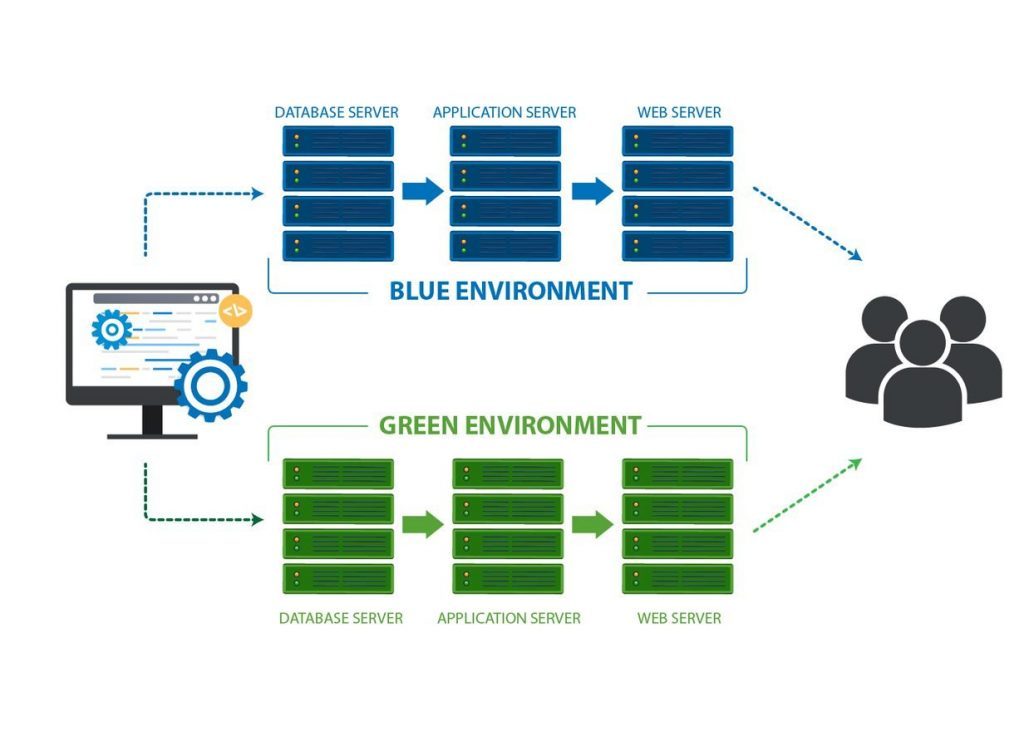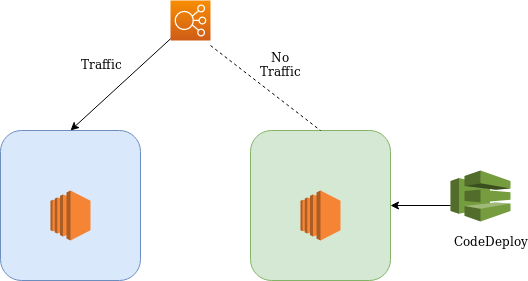
Blue-green deployment is a release management technique that reduces risk and minimizes downtime. It uses two production environments, known as Blue and Green, to provide reliable testing, continuous no-outage upgrades, and instant rollbacks.
- Introduction
- The Origins of Blue-Green Deployments
- How Do Blue-Green Deployments Work?
- Tools and Services for Set-Up
- The advent of Cloud in Blue-Green Deployment
- AWS Services for Blue-Green Deployment
- Utilizing Elastic Beanstalk and trading Application
- Who Can Benefit from Blue-Green Deployments?
- Blue green deployment and Kubernetes
Introduction:-

Blue green sending is an application discharge model that bit by bit moves client traffic from a past adaptation of an application or microservice to an almost indistinguishable new delivery—the two of which are running underway.
The old adaptation can be known as the blue climate while the new form can be known as the green climate. When creation traffic is completely moved from blue to green, blue can backup if there should arise an occurrence of rollback or pulled from creation and refreshed to turn into the format whereupon the following update is made.
There are drawbacks to this ceaseless sending model. Not all conditions have similar uptime prerequisites or the assets to appropriately perform CI/CD cycles like blue green. Be that as it may, numerous applications develop to help such constant conveyance as the endeavors supporting them carefully change.
- The story starts around 2005, with two designers and an issue. The online business website they were chipping away at was showing numerous unforeseen mistakes. These designers were careful and had a decent test suite set up, at the same time, for reasons unknown, blunders were flying under the radar and arriving at creation. The entire circumstance was bringing a ton of hardship for their clients.
- Upon a more top to bottom assessment, they tracked down the reason They saw that there were such a large number of contrasts between the creation and test machines. Their tests were breezing through in the assessment climate, yet the code was bombing when conveyed underway.
- These designers, Daniel North and Jez Humble, then, at that point, had a whimsical yet splendid thought. They would convey and test straightforwardly underway.
- Presently I can read your mind. Isn’t trying underway a major no-no? Typically, yes. However the central issue here is that they weren’t overwriting the old site. All things being equal, they were running the upgraded one next to each other, in a similar actual box, so clients knew nothing about the continuous organization. The old site kept filling in as common while Dan and Jez dealt with the delivery.
- The arrangement worked this way. They replicated the organizer containing the most recent adaptation into the creation machine. Then, at that point, they began the site utilizing a different area and smoke-tried it not too far off. When they were glad, they would point the Apache web server to the new envelope, punch out, and apparently have beer all around. In the case of anything went south, they could point the web server back to the old organizer, fix the blunders, and attempt once more. This procedure incredibly further developed blunder identification since test and creation conditions were currently something very similar.
The Origins of Blue-Green Deployments:-
How Do Blue-Green Deployments Work?
With a couple of provisos that we’ll investigate later, blue-green basically checks every one of the containers for an ideal arrangement process:
Consistent: clients shouldn’t encounter any vacation.
Safe: slim likelihood of disappointment.
Completely reversible: we can fix the change without unfriendly impacts.
The premise of the blue-green technique is one next to the other organizations. For that, we really want two separate yet indistinguishable conditions. What’s more I mean climate in the most broad manner, including servers, virtual machines, compartments, arrangements, information bases, in addition to other things. Now and again we can utilize various boxes. Different occasions we can utilize separate virtual machines running on a similar equipment. Or on the other hand they can be various compartments running in a solitary gadget.
Tools and Services for Set-Up:-
In light of framework and application, there are different administrations for example Docker, Kubernetes, Cloud, Cloudfoundry etc accessible which can be utilized to implement Blue-Green Deployment.
We will talk about further on Blue Green arrangement on Cloud and the means to implement it.
The advent of Cloud in Blue-Green Deployment:-
The appearance of distributed computing in arrangement has helped the framework to reduce associated hazards.
Cloud utilities of infra the board, charging and mechanization have made it simpler to implement Blue-Green Deployment, making it a speedier errand at a lower cost.
- DNS Routing with Route53
- Trading of Autoscaling Group with ELB
- Utilizing Elastic Beanstalk and trading Application
- Blue-Green Deployment utilizing AWS Code Deploy
- Cloning Stack in OpsWork and Updating DNS.
AWS Services for Blue-Green Deployment:-

By using AWS for Blue-Green Deployment, we can get to many administrations that help in mechanization of deployment and foundation for example AWS CLI, SDK, ELB, Elastic Beanstalk, CloudFormation etc. There are various arrangements that AWS gives which we can utilize, some of them being:
- Steps to perform Blue-Green organization in AWS:
- Open Elastic Beanstalk console from AWS and select the Region where we want to set up a climate.
- Possibly we can send off another climate or clone the current climate.
- Send and test the new application climate. For sending, the new form picks Environment and name from the rundown. Click on transfer and send.
- We can utilize screen structure to transfer source pack.
- On the Overview page, pick Environment activity and pick Swap climate URL.
- Pick the climate name, under Select a climate to trade section and snap on Swap.
- Steps to perform Blue-Green sending in AWS
Utilizing Elastic Beanstalk and trading Application:-
Versatile Beanstalk gives us the simplicity in sending. When we transfer application code with some adaptation on Elastic Beanstalk and give data about application, it sends our application in Blue Environment and give its URL.
The above Environment setup is then replicated and used to send off the new form of utilization for example Green Environment with its unique and own URL.
This mark of time our application is Up with two conditions however traffic is going just to Blue Environment.
For Switching the climate to Green and serving traffic to it, we really want to pick other Environment subtleties from Elastic Beanstalk Console and Swap it utilizing Action menu. It drives Elastic Beanstalk to perform DNS Switch and when DNS changes are done, we can end Blue Environment. Thusly, traffic will be diverted to Green Environment.
- There should be identical and secluded conditions.
- There should be the arrangement for switch or Load Balancer.
- Framework should work with Continuous Update.
Who Can Benefit from Blue-Green Deployments?
Blue-Green Deployment provides us with minimum Down Time and dependable sending.
Blue-Green Deployment has become valuable in deploying an application for Development Teams, however it can be used under the beneath situations:
Blue green deployment and Kubernetes:-
Kubernetes is a natural fit with all the elements associated with the blue green deployment process, including cloud-native apps, microservices, containers, continuous integration, continuous delivery, continuous deployment, SRE, and DevOps. As an open source platform that automates Linux® container operations, Kubernetes not only helps orchestrate the containers that package cloud-native apps’ microservices, but Kubernetes is also supported by a collection of architectural patterns that developers can reuse instead of creating application architectures from scratch.
One of those Kubernetes patterns is known as the Declarative Deployment pattern. Since microservices are inherently small, they can multiply in number very quickly. The Declarative Deployment pattern reduces the manual effort needed to deploy new pods—the smallest and simplest unit in the Kubernetes architecture.





